When: 11 December 2018
Where: Washington DC, United States
Chair of the International Accounting Standards Board (Board) Hans Hoogervorst delivered a speech at the annual conference on regulatory developments organised by the American Institute of Certified Public Accountants. Mr Hoogervorst described the Board’s own response to the global financial crisis—the new financial instruments Standard, IFRS 9—and discussed current risks in the global financial system, asking whether previous lessons have been learned.
The year 2018 marked the 10th anniversary of the outbreak of the Global Financial Crisis. Many retrospectives have been written this year and many of them questioned whether enough has been done to prevent a new crisis.

I know that the American economy is booming, so many of you may wonder: crisis, what crisis? Well, let me start by showing you a picture that tells more than a thousand words.
The next slide ('Global debt by sector ($1 trillion)') shows you the development of total global debt since the beginning of this century. You can see that the combined debt of consumers, banks, corporates and governments amounted to no less than 269% of GDP at the outbreak of the financial crisis. Never in history had global debt been so high as it was in 2008. Economists agreed that this excessive leverage was the major cause of the financial crisis.
Normally excessive leverage is reduced after a financial crisis. This time, however, total debt continued to grow to a staggering 318% of global GDP in 2018, almost 50 percentage points higher than the historical record of 2008.
One of the main drivers was the growth of public debt, also here in the United States, where government debt is now more than 100% of GDP. Corporate debt has also exploded, especially in ‘junk territory’.
The next slide ('Interest rates down, dept up') indicates that monetary policies played a major role in the growth of debt. The unconventional monetary policies of central banks served to make debt very cheap. Unsurprisingly, markets reacted by accumulating more and more of it.
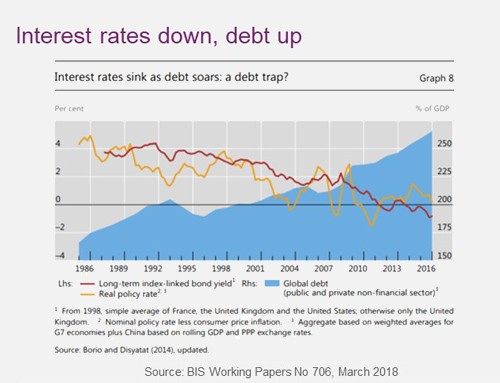
One could argue that the global economy is caught in a classical debt trap. Debt is high because interest rates are low. At the same time, interest rates are low because debt is so high. A lot of debt can only be serviced while interest rates remain low, so it is very hard to return to monetary normalcy. Central banks are very cautious with raising interest rates, because they are fearful of accidents along the way.
My prediction is that—even if we continue to muddle through as we are now—major accidents will be hard to avoid. It is very unlikely that the huge mountain of debt that we have created can ever be repaid in an orderly fashion.
So the question—are we prepared for the next crisis?—seems to be more than justified.
On this cheerful note, let’s turn to the question of whether accounting standards are fit for purpose in a new financial crisis.
Both the IASB and the FASB reacted to the financial crisis by replacing the incurred loss model for loan losses with an expected loss model.
During the financial crisis, it became clear that the incurred loss model gave too much leeway for banks to postpone recognising inevitable loan losses for too long. The IFRS 9 expected loss model is different from the FASB’s CECL model, but both models have in common that they will lead to much quicker loss recognition than was the case in 2008.
While this was exactly what the G20 wanted us to do, some in the financial industry are now worried that IFRS 9 might exacerbate procyclicality. Since economic expectations might be overly pessimistic during a recession, they fear IFRS 9 will lead to overreaction. According to these critics, the requirement that full lifetime expected losses will have to be recognised as soon as a loan has become significantly riskier, may strengthen the downward turn of the economic cycle.
Although I understand these fears, I do not believe them to be justified.
First, the fact that IFRS 9 leads to a much quicker crystallisation of loan losses should have a preventative effect. My impression is that the introduction of the expected loss model has contributed to improvement of credit quality control systems in the banking system.
Second, timely loan loss recognition should contribute to limiting imprudent dividend distribution and remuneration policies. Astoundingly, dividend distributions and reckless take-overs continued almost unabated during the initial phase of the crisis. This should be a thing of the past.
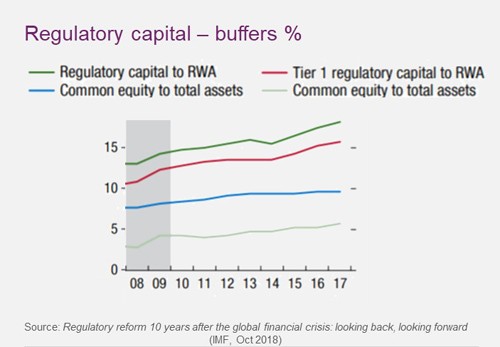
Finally, quick loan loss recognition should lead to timely clean-up of banks’ balance sheets, which in turn will contribute to much quicker restoration of credit flows to healthy companies. The prolonged extending and pretending of ‘dud’ loans has only served to prolong recessionary tendencies in some parts of the world.
Nevertheless, there is no denying that the quick loss crystallisation in an expected loss model will lead to a faster hit of bank capital, so it is essential that banks are adequately capitalised when the next crisis hits.
There can be no doubt that the capitalisation of the banking system has increased significantly since the crisis. This slide ('Regulatory capital - buffers %') shows that regulatory capital has increased from about 13% to close to 20%. However, the calculation of regulatory capital is tricky business, so I think it is also useful to look at unadjusted accounting capital. This capital ratio, shown by the light green line at the bottom, rose from about 2.5% in 2007 to just over 5% in 2017.
While this represents a doubling of capital, it came from an extraordinary low level. Given the explosion of debt outside the banking system, it remains to be seen whether the strengthening of bank capital is enough. The fact that some bank regulators are nervous about the impact of IFRS 9 indicates that this may not be the case everywhere.
IFRS 17's contribution to financial stability
Let me now turn to insurance. Given the long-term nature of the insurance liability, the insurance industry is much less prone to sudden liquidity crises than the banks. Nevertheless, with their vast holdings of financial assets, insurance companies are not immune to systemic risk. Moreover, the business model of insurance companies is under pressure by the current low interest rate environment.
In its Financial Stability Report of 20171, the International Monetary Fund (IMF) warned that, in their search for yield, insurers have taken on more credit risk and more liquidity risk. It noted that the share of lower-grade bonds held by insurance companies has gone up significantly. The IMF also noted that the industry ‘suffers from opaque and heterogeneous financial disclosures and deficiencies in the accounting and regulatory regimes’.
This is of course exactly the reason why the IASB issued IFRS 17, the new Standard for insurance contracts.
I firmly believe that IFRS 17 brings a very important contribution to financial stability in the insurance industry.
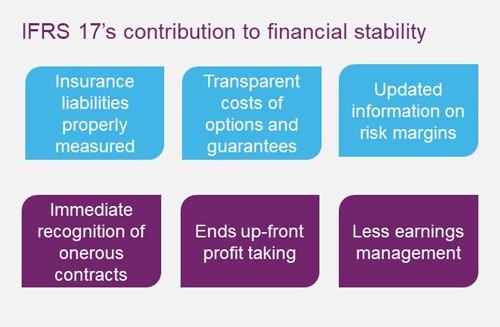
First, the insurance liability, including the costs of options and guarantees, will be properly measured and regularly updated, giving much better information. The build-up of unsustainable equity positions will become visible sooner. The FASB has made similar changes to its insurance standards, replacing historical cost measurement with current measurement.
Second, IFRS 17 ends up-front profit taking. Revenue will only be recognised as the service is provided. Clearly, this is more prudent than current practice in some parts of the world, where profits on long-term contracts like annuities can be taken upfront.
Moreover, IFRS 17 will result in much better information about profitability trends by making an end to unfettered averaging of different generations of contracts. Current accounting standards give much leeway for insurance companies to mix the profitability of different generations of contracts. Old, profitable contracts can be mixed with less profitable, newer contracts to smoothen the income statement. Old contracts can even contribute to current earnings long after they have expired!
Clearly, this practice makes it much harder for investors to discern earnings trends. It also creates room for imprudent dividend distribution even when the performance of an insurance company is worsening. IFRS 17 will instead require insurers to clearly distinguish between different vintages of insurance contracts. If profits start declining, it will be visible much earlier.
Goodwill
I will devote the final part of my speech to one of the most controversial issues in accounting standards, namely the accounting for goodwill. The IASB has been discussing the issue of goodwill in the context of the Post-implementation Review of IFRS 3, the business combinations Standard equivalent to US GAAP Standard 141R.
Our review demonstrated clearly how impairment is almost bound to be ‘too little, too late’. Our staff showed how acquired goodwill tends to be shielded by the internally generated goodwill within the acquiring company. Most acquiring companies will have built up intangible assets, such as technological know-how or customer relationships. This pre-acquisition goodwill in the old part of the business is not recognised on the balance sheet, but it contains real value.
Even if an acquisition is truly terrible, the value of the combined business may stay above its book value if it is protected by the internally generated goodwill from the old business. In practice, a company must burn through all of this headroom before the acquired goodwill becomes visibly impaired. Since the headroom can be quite substantial, our staff research made it clearer than ever before that it is almost inevitable that the results of the impairment test will be ‘too little, too late’.
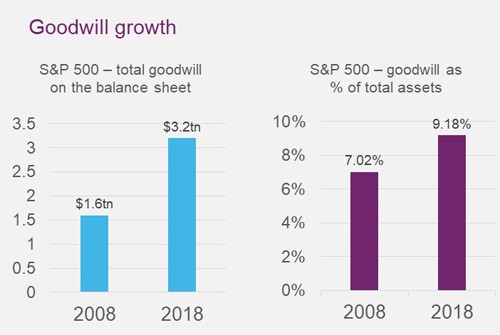
Given that IFRS 3 relies completely on the impairment test to ensure that goodwill really exists, this is a far from satisfactory situation. The risk is that goodwill just keeps on accumulating over time even when the economics do not justify this. The next slide ('Goodwill growth') gives an indication of this accumulation of goodwill since the financial crisis.
I do not believe that the accounting for goodwill poses a significant risk in terms of triggering a financial crisis. To begin with, prudential regulators typically deduct goodwill from their capital requirements, so that at least regulatory capital cannot be inflated by goodwill. However, it is never good when the balance sheet may give an overly optimistic representation of a company’s financial health. The next slide ('Goodwill - an example') shows a snapshot of the balance sheet of a company that recently went bankrupt. Without goodwill, its net assets were negative.
Although sophisticated investors should be able to see through inflated goodwill numbers, others may not. Some are also concerned that in the next financial crisis, a lot of goodwill will be impaired all at once, adding to unrest in the capital markets.
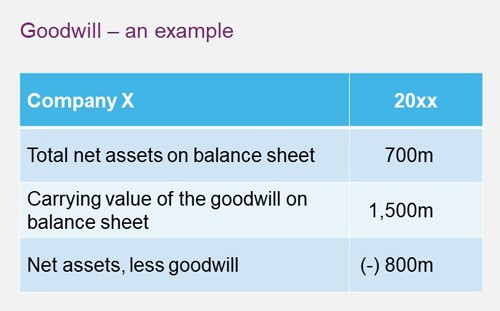
For these reasons, the IASB has decided to publish a discussion paper in which we will present some new approaches to goodwill to our stakeholders. One of the things we will look at is whether it will be possible to improve disclosures which will help investors to judge whether an acquisition has been successful or not. We could also consider a disclosure that shows what a company’s balance sheet will look like without goodwill. This might serve as a wake-up call for those investors who do not closely monitor the success of acquisitions.
Furthermore, we have decided to include a discussion on the reintroduction of amortisation of goodwill. We had originally decided not to consider reintroducing amortisation of goodwill at all, so this a major step.
However, it is a far from foregone conclusion that this discussion paper will lead to a reintroduction of amortisation. After all, there were many good reasons why our predecessors on the Board decided to get rid of it in 2004. The information value of amortisation is very low because it is impossible to determine objectively the timeline over which amortisation should occur. Goodwill is an asset with indefinite life and in some cases its value might not decrease over time.
We also know that many investors will ignore amortisation and will immediately add it back in their projections. Moreover, any major accounting change needs to pass a clear cost-benefit analysis. It is not immediately clear that reintroduction of amortisation would clear that hurdle. Finally, we would like to keep our standard converged with US Gaap.
Whatever the outcome of this exercise will be, the discussion paper should serve to make our stakeholders better aware of the shortcomings of the impairment-only approach. It may be that there is no better alternative, but in that case we should accept the current shortcomings of IFRS 3 with our eyes wide open. Should the discussion paper lead to better awareness of the possible pitfalls of current accounting for goodwill, this would in itself be a positive development.
Close
I have come to the end of my contribution. I have sketched the enormous risks in the global economy. I am not sure whether the financial system as a whole is ready for the next financial crisis. What I am sure of is that the recent improvements in our accounting standards will provide much more transparency that will help investors and regulators identify risks at a much earlier stage. That is the best contribution that accounting can give to financial stability and we believe that IFRS 9 and 17 are big improvements in this respect.
I thank you for your attention.
1https://www.imf.org/en/Publications/GFSR/Issues/2017/09/27/global-financial-stability-report-october-2017

